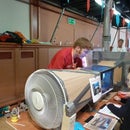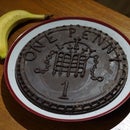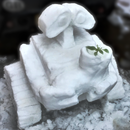Introduction: Pyrography Coasters Using a Soldering Iron
In this instructable I will explain how to do pyrography (wood burning) artwork, using the example of decorating coasters.
It should be noted I’m breaking some rules here, most pyrographers will tell you that you can’t make anything good with a soldering iron and you shouldn’t attempt pyrography on the end grain. It is fair to say that doing things properly is probably easier, but this instructable is to highlight that if all you’ve got is a soldering iron, you shouldn’t be put off.
These coasters take me about 2 hours to do.
Step 1: What You Will Need
To do some pyrography you need:
Some wood to draw on, a design you want to draw, and...
...a soldering iron - preferably a controllable one, and the more powerful the better. That said use what you’ve got... if you are buying a tool for this, buy a wood burning tool!
My iron is a 48W temperature controlled one, and it works well, but I’ve also had luck with one with an unmarked dial that presumably was just variable power. I suggest turning whatever you have up as hot as it will go (up to 430 degC which is hot enough) and trying it on some scrap wood.
I swapped tips from my usual soldering tip to a chunkier one, both to save it from damage/dirt and because coarser tips transmit more heat so work better
To make these coasters you will need wood slices. Mine were sold as blank coasters and were unfinished.
Regardless it’s probably worth having some scrap or off-cuts to practice on.
Beware any plastic-y lacquers as the fumes won’t be nice. If you have an extraction fan, it’s probably worth using it. If not, open a window or something.
Step 2: Practicing the Basics
There are three types of stroke I use:
- Lines
- Dots
- Scribble
Lines need a quick bit of practice, the other two we’ll try in the image.
Turn the iron on, select 430degC/full power if you have an adjustable one. Get a scrap piece of wood and wait for the iron to get up to temperature.
Place the side of the tip of the iron on the wood between dark grain lines/rings for about half a second. Hopefully this creates quite a dark spot. 1 second should be almost black. Adjust timings for your iron. Repeat this on a ring/grain line. Notice how it takes up to 3 times as long to get the same effect.
Now move the tip near to the top of the piece, angling the handle towards yourself. Touch the tip on the wood and draw it towards yourself at about 5mm/second. This should give you a brown line across the pale wood but will do little to the rings. Now try different speeds. For a black line, about 1mm/second works for me.
For even lines over the rings you can go back and touch them in with the tip, or if you prefer, you can speed up over pale wood and slow or pause on the rings as you draw the lines.
For pale lines, building up from a few fast sketching strokes tends to lead to more uniform lines.
Practice lines by trying writing on the wood. Remember to always pull the iron across the wood, if you pus it it will dig in momentarily and burn a spot. If needed, turn the workpiece, or build curves from two directions you can pull in.
One final thing to note is that the iron will cool as you use it, meaning you have to go slower or return to work up areas. Beware though that if you pause it will be hotter again and you might overburn when you touch it again.
Always err on the side of too light, as darkening later is easy.
Step 3: Outlining the Image
The aim here is to create a faint outline of the design. This can be done directly with the iron, as I do in the duck example pictured, or with a pencil. If freehand drawing isn’t your thing you can even do a traced rubbing transfer.
The key thing is to keep things light; dark lines are difficult to undo, as burns darken deep into the wood so don’t sand off easily, and pencil lines rub into the grain and are just smeared by sanding. The faintest marks barely darken the wood at all, but make the surface shiny.
While you should try to get things right, don’t be too scared of mistakes as long as you keep things pale they won’t be an issue. In the example I got the tail very wrong first time, and I don’t try to remove it at any point in the instructable. It is still there in the finished photos, but it is totally unnoticeable unless you look for it. I will eventually lightly sand this to remove it, but thought it was worth showing that you don’t need to get things perfect.
Step 4: Start the Shading - Dark Regions
Once the outline is complete, I start by shading in a darker region near the edge. Until the image is complete it is difficult to judge how dark to go as the contrast is against untouched wood. Therefore, following the principle that you can darken but not lighten later, don’t go too dark just yet.
Dark areas can be burned in a similar way to line drawing. Use the side of the tip to ‘line in’ areas with lots of adjacent lines filling the area. For texture, variable shading or slightly less dark regions, ‘dotting in’ these areas can give more control. The process is simple: dab the tip on the surface repeatedly. Depending on the iron and wood used it may be half a second per dot, or may be more, or less; use the timing of the spot you did when practicing as a guide, or just gradually increase the touch time and see what happens. Once you are getting it consistent, fill the areas, varying the darkness as required. Dotting works for most of the shades, and the next step will detail how to get smoother appearance in paler areas.
Step 5: Shading Lighter Areas
As you move to lighter areas, you have a number of options how to darken the wood, each with their own look:
1. Sparse darker dotting: easiest but leaves visible texture/pattern. Used on the bluetit, robin and blackbird. Make dots as before, spacing them to give paler shades. I really like this method, as it is a style I often use with a fineliner pen.
2. Pale dense dotting: difficult as occasional dark dots can appear. Used on the wing of the bluetit and the neck of the duck. Make dots much paler, rather than varying density. This is tricky because the time window at the right darkness is very short. To make it easier, I recommend several taps rather than holding the tip on. Gradually build up the heat with a series of 1/10 second taps
3. Scribble:
Step 6: Finishing Off
Firstly, I like to add a small amount of scenery to give context to the bird. Don’t add too much or the coaster will look too busy and the bird won’t stand out.
Once the composition is complete, you can check you are happy with the relative darkness of the various areas. This is the time to work up any areas you started cautiously with and get the level of contrast you want.
Use scribble or tap-dotting to darken areas you think need it, noting that once an area is browned, it takes much less time to darken it further than it did from raw.
Finally, I add some stick on feet to the underside to prevent scratching any tables.
Step 7: And You Are Done!
Hopefully you have now completed your first masterpiece.
A couple of important things to point out:
1. Stop when it is done: don’t be tempted to keep darkening and darkening until your wood is a frazzled ember!
2. Beware of lacquers and oils: It is tempting to add varnish, lacquer or oil to the wood, but this may affect your artwork. I made the mistake of applying Danish oil to some of my work, and it really messed up the image contrast. Much of the browning seemed to dissolve and be washed away, while at the same time the wood grain was darkened. I ended up re-burning most of the images (with fume extraction). I’d suggest testing any finish you intend to use on a scrap with some sample wood burning to check it won’t ruin your work.
I hope you have enjoyed this instructable, if so please vote for me in the woodwork contest.

Participated in the
Woodworking Contest













